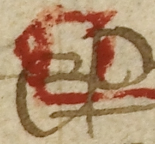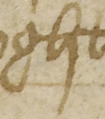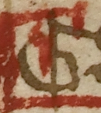|
| A |
 | Usage: that
'a' is a double compartment letter but all the scribe's graphs are sloppily formed so that it sometimes difficult to tell one from another. |  | Usage: Stomak
although in the middle of a word the graph is larger than the letters around it. |
 | Usage: maist(er)
although here 'a' stands way above surrounding graphs, the scribe is not consistent in doing this and sometimes, 'a' is the same size as other graphs. |  | Usage: And
upper case 'A' tipped with red ink. |
|
| D |
 | Usage: dele
most of the scribe's 'd's have a long loop backwards. |  | Usage: bedde |
 | Usage: hed
'd' in final position with trailing tag. |  | Usage: De
upper case 'D' with vertical bisecting bar and a '2'-shaped element preceding the body of the graph. |
|
| G |
 | Usage: gyff
the scribe's 'g's all have a tail which loops round counter-clockwise. |  | Usage: rynnyng
'g' in final position with tag. |
 | Usage: vpryghte
the 'ght' combination. |  | Usage: Galien
upper case 'G' with vertical bisect. |
|
| H |
 | Usage: hit
'h' is a graph which is formed fairly consistently. The limb may be straight as here or the tail may loop round to join to following graphs as in versions 2 and 3. |  | Usage: hed |
 | Usage: nose thrylles
the cross-bar from 't' links through to provide the starting point for 'h'. |  | Usage: he
a longer than usual tail because the word is on the bottom line. |
|
| R |
 | Usage: reyne
long 'r' is used in all positions except after 'o', 'e' and 'a'. |  | Usage: parte
the fork of 'r' varies according to the following graph. In version 1 the fork is just below the level of the following 'e' whereas the fork in this example is at the lowest point of the descending stroke. |
 | Usage: forhed
'z'-shaped 'r' is used after 'o', 'e' and 'a'. |  | Usage: Rosis
upper case 'R' with looped head traced at a distance from the body of the graph. |
|
| S |
 | Usage: side
long 's' is used in initial and medial positions. |  | Usage: is
sigma 's' is always used in final position. |
 | Usage: sais
both versions of 's' are used in this example. | | Usage: Stomak
a strange variety of upper case 'S'. |
|
| W |
 | Usage: knowe
the scribe has several versions of 'w'. This one is clearly 'w', others are not so obvious. |  | Usage: draw
a crouched 'w' graph. |
 | Usage: swaloe
difficult to disentangle this 'w' which appears wedged between initial long 's' and following 'a'. |  | Usage: wt
the scribe is fond of using abbreviations for 'with' and 'that'. |
|
| Y |
 | Usage: ryght
'y' is almost indistinguishable from thorn. It is consistently formed usually with fairly long tail stroke. |  | Usage: coleryk |
 | Usage: gyff
a shortened tail stroke in this word. |  | Usage: mylke
again, a sweeping tail for 'y'. |
|
| Thorn and Yogh |
 | Usage: þt
it is sometimes difficult to distinguish between 'y' and 'thorn'. |  | Usage: þ(er)to
here the scribe has extended the tail of thorn to end above the graph to form the 'er' abbreviative mark. |
 | Usage: yf þe
this image demonstrates the possible problems with reading this script. |  | Usage: ȝe
a solitary yogh on this folio. |
|
| Upper Case Letters |
 | Usage: Constantyne
the scribe's upper case graphs can also be confusing. At first glance 'C' is very similar to version 2 which shows 'T'. |  | Usage: Thus |
 | Usage: Nodull |  | Usage: Blode
like the 'D' graph, 'B' also has a 2-shaped element preceding the rest of the letter. |









































